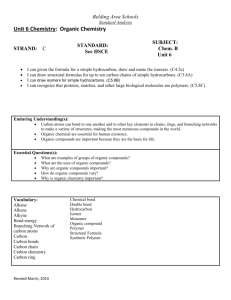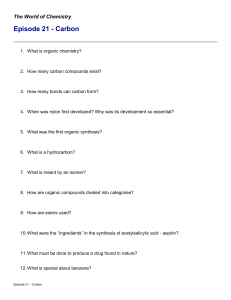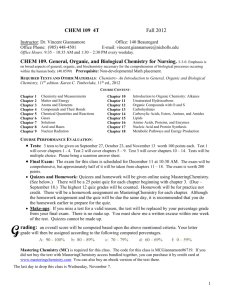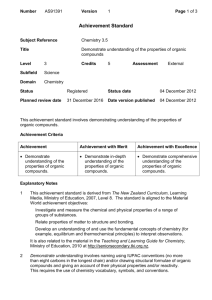chemistry 90698 - No Brain Too Small
advertisement
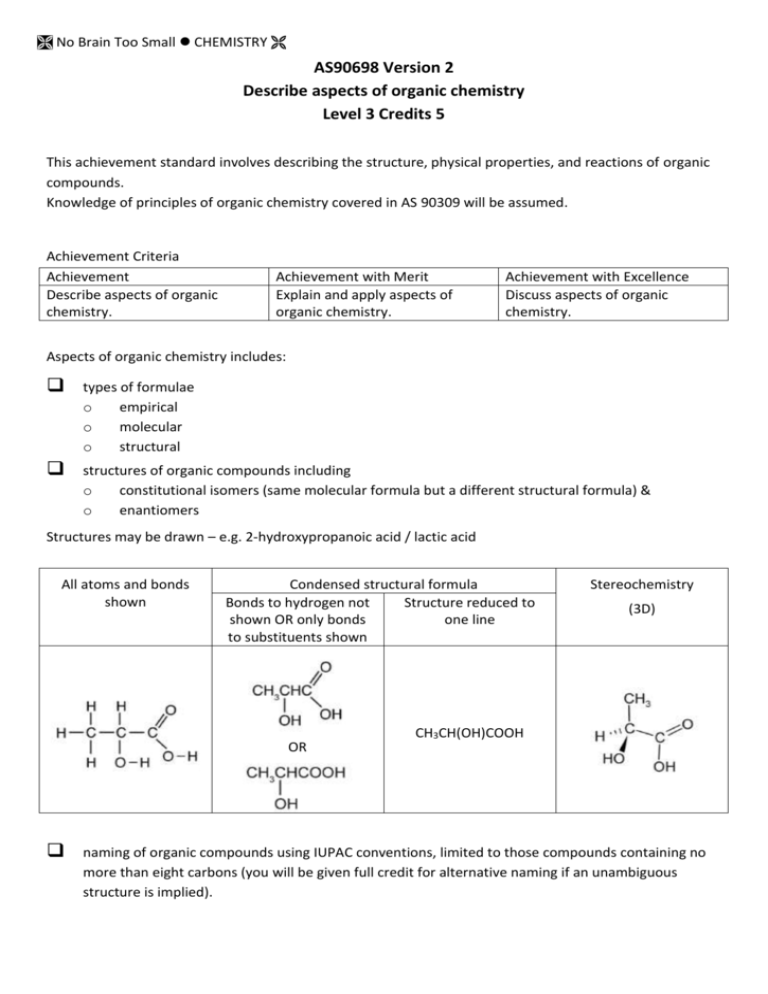
No Brain Too Small CHEMISTRY AS90698 Version 2 Describe aspects of organic chemistry Level 3 Credits 5 This achievement standard involves describing the structure, physical properties, and reactions of organic compounds. Knowledge of principles of organic chemistry covered in AS 90309 will be assumed. Achievement Criteria Achievement Describe aspects of organic chemistry. Achievement with Merit Explain and apply aspects of organic chemistry. Achievement with Excellence Discuss aspects of organic chemistry. Aspects of organic chemistry includes: types of formulae o empirical o molecular o structural structures of organic compounds including o constitutional isomers (same molecular formula but a different structural formula) & o enantiomers Structures may be drawn – e.g. 2-hydroxypropanoic acid / lactic acid All atoms and bonds shown Condensed structural formula Bonds to hydrogen not Structure reduced to shown OR only bonds one line to substituents shown Stereochemistry (3D) CH3CH(OH)COOH OR naming of organic compounds using IUPAC conventions, limited to those compounds containing no more than eight carbons (you will be given full credit for alternative naming if an unambiguous structure is implied). No Brain Too Small CHEMISTRY physical properties of organic compounds o solubility o melting point & boiling point o rotation of plane-polarised light reactions of organic compounds o acid-base; reactions of carboxylic acids amines carboxylate alkyl ammonium salts o oxidation; is limited to reactions using the following reagents: MnO4–/H+, warm Cr2O72–/H+, warm Tollens’ (silver mirror test): Ag+/NH3 warm Fehling’s and Benedict’s: Cu2+, warm o elimination; is limited to reactions using the following reagents: KOH in alcohol* (*favours elimination instead of substitution) concentrated H2SO4 : dehydration o substitution reactions; including esterification, hydrolysis, and polymerisation; limited to reactions using the following reagents: concentrated HCl, HBr, SOCl2, PCl3, PCl5, NaOH, KOH (in alcohol or aqueous solution), NH3, primary amines, primary alcohols/H+, primary alcohols, H2O/H+, H2O/OH– esterification hydrolysis – acid hydrolysis H2O/H+, alkaline hydrolysis H2O/OH– polymerisation limited to formation of polyesters polyamides including proteins (names of amino acids not needed) Organic compounds are limited to those containing one or more of the following functional groups: alkene haloalkane amine alcohol aldehyde ketone ester acyl chloride (acid chloride) amide carboxylic acid Terms Describe involves identifying, naming, drawing, giving characteristics of, giving an account of, and/or defining. Explain and apply involves describing as well as giving reasons for, making links between chemical concepts and/or observations. Discuss involves showing understanding by analysing, interpreting, justifying, relating, evaluating, and/or comparing and contrasting.



